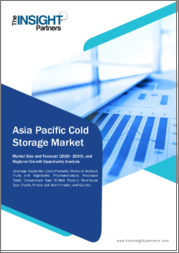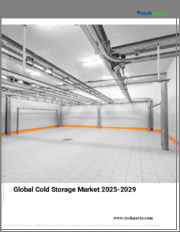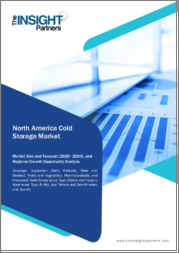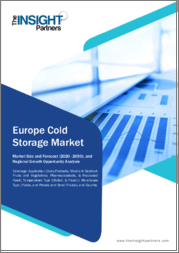
|
시장보고서
상품코드
1592638
아시아태평양의 냉장 창고 시장 예측(-2030년) - 지역별 분석 : 용도별, 온도별, 창고 유형별, 지역별Asia Pacific Cold Storage Market Forecast to 2030 - Regional Analysis - by Application, Temperature Type, and Warehouse Type |
||||||
아시아태평양의 냉장 창고 시장은 2022년 260억 1,841만 달러, 2030년까지 1,006억 6,254만 달러에 달할 것으로 예상되며, 2022-2030년간 18.4%의 연평균 복합 성장률(CAGR)을 나타낼 전망입니다.
지속 가능한 냉동 및 저장 기술, 아시아태평양의 냉장창고 시장을 견인합니다.
초임계 CO2 시스템은 오존층 파괴지수(ODP)가 매우 낮은 이산화탄소(CO2)를 냉매로 사용합니다. 오존층 파괴의 원인이 되는 수소불화탄소(HFC)나 수소염화불화탄소(HCFC)와 같은 기존 냉매와 달리, CO2는 오존층을 파괴하지 않습니다. 이러한 특성으로 인해 초임계 CO2 냉동 시스템은 환경 친화적이며, 오존층 파괴 물질의 단계적 감축을 위한 전 세계적인 노력에 동참할 수 있습니다. 초임계 CO2 시스템은 기존의 많은 냉장 시설에 비해 지구온난화지수(GWP)가 크게 낮으며, GWP는 온실가스가 일정 기간 동안 지구 온난화에 영향을 미치는 능력을 측정한 것으로, CO2의 GWP는 1인 반면, 냉동 시스템에 일반적으로 사용되는 HFC의 GWP는 1입니다. 초임계압 시스템은 CO2를 냉매로 사용함으로써 기후 변화를 완화하고 냉방 및 냉장 용도의 이산화탄소 배출량을 줄일 수 있습니다. 전반적으로 저온 저장 초임계 CO2 시스템의 낮은 환경 영향은 세계 환경 목표를 지원함으로써 시장을 주도하고 있습니다. 지속 가능한 냉동 및 저장 솔루션에 대한 요구가 계속 발전함에 따라, 저온 저장 초임계 CO2 기술은 다양한 분야의 비즈니스에 실행 가능하고 현명한 선택을 제공합니다. 또한, 저온 저장 기술의 적용은 환경 친화적인 저장 시설에 대한 대안 중 하나이며, 예측 기간 동안 저온 저장 시장에 기회를 제공할 수 있습니다.
아태지역 냉장창고 시장 개요
인구 증가, 소비자 소득 증가, 가공식품 및 통조림 식품에 대한 선호도 증가는 저온 저장 시장에 긍정적인 영향을 미치고 있습니다. 최근 몇 년동안 편의식품, 냉동식품, 프로바이오틱스, 의약품, 신선식품에 대한 지출이 증가함에 따라 냉장시설의 인기와 중요성이 급증하고 있습니다. 식음료, 제약, 화학 등 여러 산업에서 제품 보존을 위해 냉장 시설을 활용하고 있습니다. 식품 산업에서는 냉동 식품과 신선 식품에 대한 수요가 증가함에 따라 제품의 신선도를 유지하고 부패를 방지하기 위해 저온 저장 시설이 필수적입니다. 제약업계는 온도 조절이 가능한 백신과 의약품의 효능을 유지하기 위해 냉장 창고에 크게 의존하고 있습니다.
세계화와 운송 물류의 확대는 다양한 제품의 국내 또는 국제 공급망에 대한 수요를 증가시키고 있습니다. 이러한 추세는 거리와 이동 시간에 관계없이 제품이 필요한 온도를 유지하면서 이상적인 상태로 소비자에게 도달할 수 있도록 하기 위해 냉장 창고에 대한 수요를 증가시키고 있습니다.
온라인 식료품 판매와 전자상거래 플랫폼의 인기 증가는 팬데믹과 사회적 거리두기로 인해 더욱 증가하여 시장 성장에 크게 기여하고 있습니다. 또한, 제품의 활발한 수출입을 지원하기 위한 제도와 정책을 시행하는 정부의 이니셔티브이 확대되고 있는 것도 아시아태평양의 냉장 창고 시장의 성장을 가속하고 있습니다.
아시아태평양의 냉장 창고 시장 매출 및 2030년까지의 예측(금액)
아시아태평양의 냉장창고 시장 세분화
아시아태평양의 냉장 창고 시장은 용도, 온도 유형, 창고 유형 및 국가별로 분류됩니다.
용도별로 아시아태평양의 냉장창고 시장은 유제품, 육류 및 해산물, 과일 및 채소, 의약품, 가공식품으로 구분됩니다. 육류 및 해산물 부문은 2022년 아시아태평양의 냉장 창고 시장에서 가장 큰 점유율을 차지했습니다.
온도 유형에 따라 아시아태평양의 냉장 창고 시장은 냉장 및 냉동으로 나뉘며, 2022년 아시아태평양의 냉장 창고 시장 점유율은 냉동 부문이 더 큽니다.
창고 유형에 따라 아시아태평양의 냉장창고 시장은 공공과 민간 및 반민간으로 구분되며, 2022년 아시아태평양의 냉장창고 시장 점유율은 공공 부문이 더 클 것입니다.
국가별로는 아시아태평양의 냉장 창고 시장은 호주, 중국, 일본, 일본, 인도, 한국, 기타 아시아태평양으로 구분되며, 2022년 아시아태평양의 냉장 창고 시장 점유율은 중국이 독차지했습니다.
Nichirei Corp, Americold Realty Trust Inc, Lineage Logistics Holdings LLC, NewCold Cooperatief UA 등이 아시아태평양의 냉장 창고 시장에서 사업을 운영하는 주요 기업입니다.
목차
제1장 서론
제2장 주요 요약
- 주요 인사이트
- 시장의 매력
제3장 조사 방법
- 조사 범위
- 2차 조사
- 1차 조사
제4장 아시아태평양의 냉장 창고 시장 구도
- 생태계 분석
- 생산자
- 보관업자
- 최종사용자
제5장 아시아태평양의 냉장 창고 시장 : 주요 시장 역학
- 시장 성장 촉진요인
- 시장 성장 억제요인
- 시장 기회
- 향후 동향
- 성장 촉진요인과 억제요인의 영향
제6장 냉장 창고 시장 : 아시아태평양 시장 분석
- 냉장 창고 시장 매출, 2022년-2030년
- 냉장 창고 시장 예측 분석
제7장 아시아태평양의 냉장 창고 시장 분석 : 용도별
- 유제품
- 육류 및 어개류
- 과일 및 채소
- 의약품
- 가공식품
제8장 아시아태평양의 냉장 창고 시장 분석 : 온도 유형별
- 냉동
- 냉동
제9장 아시아태평양의 냉장 창고 시장 분석 : 창고 유형별
- 공영
- 사영/반사영
제10장 아시아태평양의 냉장 창고 시장 : 국가별 분석
- 아시아태평양
- 호주
- 중국
- 인도
- 일본
- 한국
- 기타 아시아태평양
제11장 업계 상황
- 시장 이니셔티브
- 인수합병(M&A)
제12장 기업 개요
- Nichirei Corp
- Americold Realty Trust Inc
- Lineage Logistics Holdings LLC
- NewCold Cooperatief UA
제13장 부록
LSH 24.11.28The Asia Pacific cold storage market was valued at US$ 26,018.41 million in 2022 and is expected to reach US$ 100,662.54 million by 2030; it is estimated to register a CAGR of 18.4% from 2022 to 2030.
Sustainable Refrigeration and Storage Technologies Boost Asia Pacific Cold Storage Market
The application of transcritical CO2 systems uses carbon dioxide (CO2) as a refrigerant, which has a very low ozone depletion potential (ODP). Unlike conventional refrigerants such as hydrofluorocarbons (HFCs) or hydrochlorofluorocarbons (HCFCs), which contribute to ozone layer depletion, CO2 does not damage the ozone layer. This characteristic makes cold storage transcritical CO2 refrigeration systems environmentally friendly and supports global efforts to phase out ozone-depleting substances. Transcritical CO2 systems have a substantially minimalized global warming potential (GWP) compared to many conventional cold storage facilities. GWP measures the ability of greenhouse gases to impact global warming over a definite period. CO2 has a GWP of 1, whereas HFCs commonly used in refrigeration systems have GWPs in the thousands or even tens of thousands. By using CO2 as a refrigerant, transcritical systems help moderate climate change and reduce the carbon footprint of cooling and refrigeration applications. Overall, the low environmental impact of cold storage transcritical CO2 systems are driving the market by supporting global environmental objectives. As the need for sustainable refrigeration and storage solutions continues to develop, cold storage transcritical CO2 technology offers a viable and smart option for businesses across various sectors. Furthermore, the application of cold thermal storage technology is also one of the environment-friendly alternatives for storage facilities that can provide opportunities for the cold storage market over the forecast period.
Asia Pacific Cold Storage Market Overview
The increasing population, rising consumer income, and growing preference for processed and canned food have positively favored the cold storage market. The popularity and importance of cold storage facilities have soared in recent years owing to increased expenditure on convenience and frozen food, probiotics, pharmaceuticals, or fresh produce. Several industries, such as food & beverages, pharmaceuticals, and chemicals, rely on cold storage facilities to preserve their products. In the food industry, the mounting demand for frozen and fresh foods has made cold storage facilities crucial for preserving product freshness and avoiding spoilage. The pharmaceutical industry immensely depends on cold storage to conserve the effectiveness of temperature-controlled vaccines and drugs.
Globalization and expansion in transport logistics have also boosted the supply chain of various products nationally or internationally. This trend has improved the demand for cold storage facilities to make certain that the products reach consumers in ideal condition, preserving a necessary temperature, regardless of distance and time of travel.
The growing popularity of online grocery sales and e-commerce platforms, which were further augmented by the pandemic and social distancing, majorly contribute to the market growth. Furthermore, the growing government initiatives to implement schemes and policies that support vigorous import and export of products are boosting the growth of the cold storage market in Asia Pacific.
Asia Pacific Cold Storage Market Revenue and Forecast to 2030 (US$ Million)
Asia Pacific Cold Storage Market Segmentation
The Asia Pacific cold storage market is categorized into application, temperature type, warehouse type, and country.
Based on application, the Asia Pacific cold storage market is segmented into dairy products, meat and seafood, fruits and vegetables, pharmaceuticals, and processed food. The meat and seafood segment held the largest Asia Pacific cold storage market share in 2022.
In terms of temperature type, the Asia Pacific cold storage market is bifurcated into chilled and frozen. The frozen segment held a larger Asia Pacific cold storage market share in 2022.
By warehouse type, the Asia Pacific cold storage market is segmented into public and private & semi-private. The public segment held a larger Asia Pacific cold storage market share in 2022.
By country, the Asia Pacific cold storage market is segmented into Australia, China, Japan, India, South Korea, and the Rest of Asia Pacific. China dominated the Asia Pacific cold storage market share in 2022.
Nichirei Corp, Americold Realty Trust Inc, Lineage Logistics Holdings LLC, and NewCold Cooperatief UA are some of the leading companies operating in the Asia Pacific cold storage market.
Table Of Contents
1. Introduction
- 1.1 The Insight Partners Research Report Guidance
- 1.2 Market Segmentation
2. Executive Summary
- 2.1 Key Insights
- 2.2 Market Attractiveness
3. Research Methodology
- 3.1 Coverage
- 3.2 Secondary Research
- 3.3 Primary Research
4. Asia Pacific Cold Storage Market Landscape
- 4.1 Overview
- 4.2 Ecosystem Analysis
- 4.2.1 Producers
- 4.2.2 Storage Providers
- 4.2.3 End Users
5. Asia Pacific Cold Storage Market - Key Market Dynamics
- 5.1 Market Drivers
- 5.1.1 Rapid Growth in Import and Export Activities of Food and Pharmaceutical Products
- 5.1.2 Increasing Demand for Convenience Food Among Consumers
- 5.1.3 Rise in Food Waste
- 5.2 Market Restraints
- 5.2.1 Adverse Impact of Cold Storage Facilities on Environment
- 5.3 Market Opportunities
- 5.3.1 Sustainable Refrigeration and Storage Technologies
- 5.4 Future Trends
- 5.4.1 Automation in Cold Storage Facilities
- 5.5 Impact of Drivers and Restraints:
6. Cold Storage Market -Asia Pacific Market Analysis
- 6.1 Cold Storage Market Revenue (US$ Million), 2022-2030
- 6.2 Cold Storage Market Forecast Analysis
7. Asia Pacific Cold Storage Market Analysis - by Application
- 7.1 Dairy Products
- 7.1.1 Overview
- 7.1.2 Dairy Products: Cold Storage Market - Revenue and Forecast to 2030 (US$ Million)
- 7.2 Meat and Seafood
- 7.2.1 Overview
- 7.2.2 Meat and Seafood: Cold Storage Market - Revenue and Forecast to 2030 (US$ Million)
- 7.3 Fruits and Vegetables
- 7.3.1 Overview
- 7.3.2 Fruits and Vegetables: Cold Storage Market - Revenue and Forecast to 2030 (US$ Million)
- 7.4 Pharmaceuticals
- 7.4.1 Overview
- 7.4.2 Pharmaceuticals: Cold Storage Market - Revenue and Forecast to 2030 (US$ Million)
- 7.5 Processed Food
- 7.5.1 Overview
- 7.5.2 Processed Food: Cold Storage Market - Revenue and Forecast to 2030 (US$ Million)
8. Asia Pacific Cold Storage Market Analysis - by Temperature Type
- 8.1 Chilled
- 8.1.1 Overview
- 8.1.2 Chilled: Cold Storage Market - Revenue and Forecast to 2030 (US$ Million)
- 8.2 Frozen
- 8.2.1 Overview
- 8.2.2 Frozen: Cold Storage Market - Revenue and Forecast to 2030 (US$ Million)
9. Asia Pacific Cold Storage Market Analysis - by Warehouse Type
- 9.1 Public
- 9.1.1 Overview
- 9.1.2 Public: Cold Storage Market - Revenue and Forecast to 2030 (US$ Million)
- 9.2 Private and Semi-Private
- 9.2.1 Overview
- 9.2.2 Private and Semi-Private: Cold Storage Market - Revenue and Forecast to 2030 (US$ Million)
10. Asia Pacific Cold Storage Market - Country Analysis
- 10.1 Asia Pacific
- 10.1.1 Asia Pacific Cold Storage Market Overview
- 10.1.2 Asia Pacific: Cold Storage Market - Revenue and Forecast Analysis - by Country
- 10.1.2.1 Asia Pacific: Cold Storage Market - Revenue and Forecast Analysis - by Country
- 10.1.2.2 Australia: Cold Storage Market - Revenue and Forecast to 2030 (US$ Million)
- 10.1.2.2.1 Australia: Cold Storage Market Breakdown, by Application
- 10.1.2.2.2 Australia: Cold Storage Market Breakdown, by Temperature Type
- 10.1.2.2.3 Australia: Cold Storage Market Breakdown, by Warehouse Type
- 10.1.2.3 China: Cold Storage Market - Revenue and Forecast to 2030 (US$ Million)
- 10.1.2.3.1 China: Cold Storage Market Breakdown, by Application
- 10.1.2.3.2 China: Cold Storage Market Breakdown, by Temperature Type
- 10.1.2.3.3 China: Cold Storage Market Breakdown, by Warehouse Type
- 10.1.2.4 India: Cold Storage Market - Revenue and Forecast to 2030 (US$ Million)
- 10.1.2.4.1 India: Cold Storage Market Breakdown, by Application
- 10.1.2.4.2 India: Cold Storage Market Breakdown, by Temperature Type
- 10.1.2.4.3 India: Cold Storage Market Breakdown, by Warehouse Type
- 10.1.2.5 Japan: Cold Storage Market - Revenue and Forecast to 2030 (US$ Million)
- 10.1.2.5.1 Japan: Cold Storage Market Breakdown, by Application
- 10.1.2.5.2 Japan: Cold Storage Market Breakdown, by Temperature Type
- 10.1.2.5.3 Japan: Cold Storage Market Breakdown, by Warehouse Type
- 10.1.2.6 South Korea: Cold Storage Market - Revenue and Forecast to 2030 (US$ Million)
- 10.1.2.6.1 South Korea: Cold Storage Market Breakdown, by Application
- 10.1.2.6.2 South Korea: Cold Storage Market Breakdown, by Temperature Type
- 10.1.2.6.3 South Korea: Cold Storage Market Breakdown, by Warehouse Type
- 10.1.2.7 Rest of Asia Pacific: Cold Storage Market - Revenue and Forecast to 2030 (US$ Million)
- 10.1.2.7.1 Rest of Asia Pacific: Cold Storage Market Breakdown, by Application
- 10.1.2.7.2 Rest of Asia Pacific: Cold Storage Market Breakdown, by Temperature Type
- 10.1.2.7.3 Rest of Asia Pacific: Cold Storage Market Breakdown, by Warehouse Type
11. Industry Landscape
- 11.1 Overview
- 11.2 Market Initiative
- 11.3 Merger and Acquisition
12. Company Profiles
- 12.1 Nichirei Corp
- 12.1.1 Key Facts
- 12.1.2 Business Description
- 12.1.3 Products and Services
- 12.1.4 Financial Overview
- 12.1.5 SWOT Analysis
- 12.1.6 Key Developments
- 12.2 Americold Realty Trust Inc
- 12.2.1 Key Facts
- 12.2.2 Business Description
- 12.2.3 Products and Services
- 12.2.4 Financial Overview
- 12.2.5 SWOT Analysis
- 12.2.6 Key Developments
- 12.3 Lineage Logistics Holdings LLC
- 12.3.1 Key Facts
- 12.3.2 Business Description
- 12.3.3 Products and Services
- 12.3.4 Financial Overview
- 12.3.5 SWOT Analysis
- 12.3.6 Key Developments
- 12.4 NewCold Cooperatief UA
- 12.4.1 Key Facts
- 12.4.2 Business Description
- 12.4.3 Products and Services
- 12.4.4 Financial Overview
- 12.4.5 SWOT Analysis
- 12.4.6 Key Developments
13. Appendix
- 13.1 About The Insight Partners



















